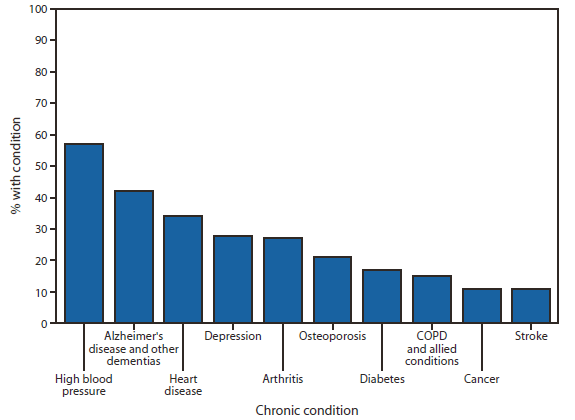50 Different Common Diseases: Essential Guide to Symptoms and Treatments


Credit: www.flickr.com
Cardiovascular Diseases
Cardiovascular diseases are disorders of the heart and blood vessels. These diseases can lead to serious health problems. Understanding them can help in prevention and treatment.
Heart Attack
A heart attack occurs when blood flow to the heart is blocked. This blockage can damage or destroy part of the heart muscle. Symptoms include chest pain, shortness of breath, and nausea. Immediate medical attention is crucial.
Stroke
A stroke happens when blood supply to the brain is interrupted. This interruption can cause brain cells to die within minutes. Symptoms include sudden weakness, confusion, and difficulty speaking. Quick treatment can save lives and reduce disability.
Hypertension
Hypertension, or high blood pressure, forces the heart to work harder. This condition can lead to heart attack, stroke, and other problems. It’s often called the “silent killer” because it shows no symptoms. Regular check-ups can help detect and manage it.
|
Cardiovascular Disease |
Key Symptoms |
Action |
|---|---|---|
|
Heart Attack |
Chest pain, shortness of breath, nausea |
Seek immediate medical attention |
|
Stroke |
Sudden weakness, confusion, difficulty speaking |
Call emergency services |
|
Hypertension |
No symptoms (silent killer) |
Regular check-ups |

Credit: www.cdc.gov
Respiratory Diseases
Respiratory diseases affect the lungs and other parts of the respiratory system. These diseases can cause breathing problems. They can also lead to other serious health issues. Here, we will discuss three common respiratory diseases: Asthma, Chronic Obstructive Pulmonary Disease (COPD), and Pneumonia.
Asthma
Asthma is a chronic condition where airways become inflamed. This inflammation leads to narrowed airways. Symptoms include wheezing, coughing, and shortness of breath.
-
Triggers: Dust, pollen, smoke, and pet dander.
-
Treatments: Inhalers, medications, and avoiding triggers.
-
Prevention: Regular exercise and breathing exercises can help manage asthma.
Chronic Obstructive Pulmonary Disease (copd)
Chronic Obstructive Pulmonary Disease (COPD) is a group of lung diseases. These diseases block airflow and make it hard to breathe. The most common types are emphysema and chronic bronchitis.
|
Risk Factors |
Symptoms |
Treatments |
|---|---|---|
|
Smoking |
Chronic cough |
Bronchodilators |
|
Air Pollution |
Shortness of breath |
Inhaled steroids |
|
Genetics |
Frequent respiratory infections |
Oxygen therapy |
Pneumonia
Pneumonia is an infection that inflames the air sacs in the lungs. The air sacs may fill with fluid or pus.
-
Causes: Bacteria, viruses, and fungi.
-
Symptoms: Cough, fever, and difficulty breathing.
-
Treatments: Antibiotics for bacterial pneumonia, antivirals for viral pneumonia.
These respiratory diseases can be serious. Early diagnosis and treatment are key to managing them effectively.
Infectious Diseases
Infectious diseases are caused by organisms such as bacteria, viruses, fungi, or parasites. These diseases can spread directly or indirectly from person to person. Understanding these illnesses helps in prevention and treatment.
Influenza
Influenza, commonly known as the flu, is a viral infection. It affects the respiratory system, including the nose, throat, and lungs.
-
Symptoms: Fever, cough, sore throat, body aches, and fatigue.
-
Transmission: Through droplets when an infected person coughs or sneezes.
-
Prevention: Annual flu vaccines, good hygiene practices.
Tuberculosis
Tuberculosis (TB) is caused by the bacteria Mycobacterium tuberculosis. It primarily affects the lungs but can spread to other organs.
-
Symptoms: Persistent cough, chest pain, coughing up blood, weight loss.
-
Transmission: Through the air from person to person.
-
Prevention: TB vaccine (BCG), wearing masks, proper ventilation.
Hiv/aids
HIV (Human Immunodeficiency Virus) attacks the body’s immune system. If untreated, it can lead to AIDS (Acquired Immunodeficiency Syndrome).
-
Symptoms: Fever, swollen lymph nodes, weight loss, recurrent infections.
-
Transmission: Through blood, sexual contact, or from mother to child.
-
Prevention: Safe sex practices, avoiding needle sharing, regular testing.
Digestive System Diseases
The digestive system is crucial for breaking down food and absorbing nutrients. When this system malfunctions, it can cause significant discomfort and health issues. Understanding common digestive system diseases can help in managing and preventing these conditions.
Irritable Bowel Syndrome (ibs)
Irritable Bowel Syndrome (IBS) affects the large intestine. It causes symptoms like cramping, abdominal pain, bloating, gas, and diarrhea or constipation. IBS is a chronic condition that requires long-term management.
Common triggers for IBS include:
-
Certain foods
-
Stress
-
Hormonal changes
Managing IBS often involves:
-
Dietary changes
-
Regular exercise
-
Medications to control symptoms
Gastroesophageal Reflux Disease (gerd)
Gastroesophageal Reflux Disease (GERD) occurs when stomach acid frequently flows back into the tube connecting your mouth and stomach. This acid reflux can irritate the lining of your esophagus.
Symptoms of GERD include:
-
Heartburn
-
Chest pain
-
Difficulty swallowing
-
Regurgitation of food or sour liquid
Managing GERD often requires lifestyle changes, such as:
-
Avoiding trigger foods
-
Eating smaller meals
-
Not lying down after a meal
-
Medications to reduce stomach acid
Celiac Disease
Celiac Disease is an immune reaction to eating gluten, a protein found in wheat, barley, and rye. This disease damages the small intestine lining and prevents nutrient absorption.
Symptoms of Celiac Disease include:
-
Diarrhea
-
Fatigue
-
Weight loss
-
Bloating and gas
-
Anemia
Treatment for Celiac Disease involves:
-
A strict gluten-free diet
-
Regular medical check-ups
-
Monitoring for complications
Understanding these digestive system diseases can help in managing symptoms effectively.
Neurological Disorders
Neurological disorders affect the brain, spine, and nerves. These conditions can impact daily life significantly. Understanding them is key for better management and care.
Alzheimer’s Disease
Alzheimer’s Disease is a progressive brain disorder. It leads to memory loss and cognitive decline. People with Alzheimer’s find it hard to remember recent events.
-
Symptoms: Memory loss, confusion, difficulty in thinking.
-
Causes: Genetic factors, age, family history.
-
Treatment: No cure, but medications can help.
Parkinson’s Disease
Parkinson’s Disease affects movement. It’s caused by the loss of dopamine-producing brain cells. Tremors are a common symptom.
-
Symptoms: Tremors, stiffness, slow movement.
-
Causes: Genetic and environmental factors.
-
Treatment: Medications and lifestyle changes.
Epilepsy
Epilepsy is a neurological disorder marked by recurrent seizures. It occurs when brain activity becomes abnormal.
-
Symptoms: Seizures, temporary confusion, staring spells.
-
Causes: Genetic influence, brain injury, unknown reasons.
-
Treatment: Anti-seizure medications, sometimes surgery.
Endocrine Disorders
The endocrine system plays a vital role in regulating body functions. Hormones control metabolism, growth, and mood. Sometimes, this system malfunctions, leading to endocrine disorders. These disorders can be serious and need medical attention.
Diabetes
Diabetes is a common endocrine disorder. It affects how the body processes blood sugar. There are two main types: Type 1 and Type 2.
-
Type 1 Diabetes: The body doesn’t produce insulin.
-
Type 2 Diabetes: The body doesn’t use insulin well.
Managing diabetes involves monitoring blood sugar levels, diet, and medication.
Hypothyroidism
Hypothyroidism occurs when the thyroid gland doesn’t produce enough hormones. This condition slows down the body’s metabolism.
Treatment usually involves daily hormone replacement tablets.
Hyperthyroidism
Hyperthyroidism is the opposite of hypothyroidism. The thyroid gland produces too many hormones. This speeds up the body’s metabolism.
Treatment options include medication, radioactive iodine, or surgery.
|
Disorder |
Key Symptoms |
Treatment |
|---|---|---|
|
Diabetes |
Increased thirst, Frequent urination |
Diet, Medication |
|
Hypothyroidism |
Fatigue, Weight gain |
Hormone replacement tablets |
|
Hyperthyroidism |
Weight loss, Rapid heartbeat |
Medication, Surgery |
Skin Conditions
Skin conditions are common and can affect anyone. They range from mild to severe. Understanding these conditions helps in managing them better. Here, we discuss three common skin conditions: eczema, psoriasis, and acne.
Eczema
Eczema is a condition that makes your skin red and itchy. It is also known as atopic dermatitis. It is common in children but can occur at any age.
-
Symptoms include red, inflamed skin.
-
Itching is usually severe.
-
Skin may become dry and cracked.
Triggers include soaps, detergents, and stress. Treatment involves moisturizers and corticosteroid creams. Avoiding triggers is also crucial.
Psoriasis
Psoriasis is a skin disease that causes red, scaly patches. It is a chronic condition and can be painful.
-
Commonly appears on the scalp, elbows, and knees.
-
Patches are itchy and sometimes painful.
-
Skin cells grow faster than normal.
Treatment options include topical ointments and light therapy. In some cases, medication may be required.
Acne
Acne is a skin condition that occurs when hair follicles are clogged with oil and dead skin cells. It is most common among teenagers.
-
Causes pimples, blackheads, and whiteheads.
-
Usually appears on the face, forehead, chest, and back.
-
Can cause scarring if not treated properly.
Treatment includes over-the-counter creams and prescription medications. Keeping the skin clean and avoiding oily products helps manage acne.
Mental Health Disorders
Mental health disorders affect how people think, feel, and act. These conditions can impact daily life, relationships, and physical health. Understanding these disorders can help in recognizing symptoms and seeking help.
Depression
Depression is a common mental health disorder. It causes persistent sadness and loss of interest. Symptoms include:
-
Feeling hopeless
-
Low energy
-
Changes in sleep and appetite
-
Difficulty concentrating
Doctors often recommend therapy and medication. Lifestyle changes, such as exercise, can also help.
Anxiety Disorders
Anxiety disorders cause excessive worry and fear. They can be crippling and affect daily activities. Types of anxiety disorders include:
-
Generalized Anxiety Disorder (GAD)
-
Panic Disorder
-
Social Anxiety Disorder
-
Specific Phobias
Common symptoms include:
-
Restlessness
-
Rapid heartbeat
-
Sweating
-
Trouble sleeping
Treatment often includes therapy and medication. Relaxation techniques, such as deep breathing, can also aid.
Bipolar Disorder
Bipolar disorder involves extreme mood swings. These mood swings include emotional highs (mania) and lows (depression). Symptoms of mania include:
-
Increased energy
-
Racing thoughts
-
Impulsive behavior
Depressive episodes have symptoms like:
-
Fatigue
-
Sadness
-
Loss of interest
Treatment usually includes medication and therapy. Monitoring and lifestyle adjustments are also crucial.
Autoimmune Diseases
Autoimmune diseases occur when the immune system attacks the body’s own cells. These conditions can affect various parts of the body, causing chronic inflammation and tissue damage. Understanding autoimmune diseases is crucial for early diagnosis and effective treatment.
Lupus
Lupus is a chronic autoimmune disease that can damage any part of the body. It primarily affects the skin, joints, and internal organs.
-
Symptoms: Fatigue, joint pain, skin rashes, and fever.
-
Diagnosis: Blood tests, urine tests, and biopsy.
-
Treatment: Anti-inflammatory drugs, corticosteroids, and immunosuppressants.
People with lupus should avoid sun exposure and manage stress.
Rheumatoid Arthritis
Rheumatoid Arthritis (RA) is an autoimmune disease that causes inflammation in the joints. It leads to pain, swelling, and eventual joint damage.
-
Symptoms: Swollen joints, morning stiffness, and fatigue.
-
Diagnosis: Blood tests, X-rays, and MRI scans.
-
Treatment: Disease-modifying antirheumatic drugs (DMARDs), NSAIDs, and biologics.
Exercise and a healthy diet can help manage RA symptoms.
Multiple Sclerosis
Multiple Sclerosis (MS) is an autoimmune disease that affects the central nervous system. The immune system attacks the protective covering of nerves.
-
Symptoms: Numbness, weakness, vision problems, and balance issues.
-
Diagnosis: MRI, spinal tap, and blood tests.
-
Treatment: Corticosteroids, plasma exchange, and immunosuppressants.
Physical therapy and medications can help manage MS symptoms.
Cancer Types
Cancer is a broad term for many diseases. It involves abnormal cell growth. Different types of cancer affect different body parts. Here are three common types:
Breast Cancer
Breast cancer starts in the cells of the breast. It can occur in both men and women, but it is rare in men. Early detection is crucial. Symptoms include a lump in the breast or underarm, changes in breast shape, and unusual discharge.
Treatments for breast cancer include:
-
Surgery
-
Radiation therapy
-
Chemotherapy
-
Hormone therapy
-
Targeted therapy
Lung Cancer
Lung cancer is a type of cancer that starts in the lungs. It is one of the leading causes of cancer deaths worldwide. Smoking is the primary risk factor. Symptoms include a persistent cough, chest pain, and shortness of breath.
Treatments for lung cancer include:
-
Surgery
-
Radiation therapy
-
Chemotherapy
-
Targeted therapy
-
Immunotherapy
Prostate Cancer
Prostate cancer occurs in the prostate gland. This gland is only in men. It is one of the most common cancers in men. Early stages may not show symptoms. Advanced stages may cause trouble urinating, blood in urine, and pelvic pain.
Treatments for prostate cancer include:
-
Active surveillance
-
Surgery
-
Radiation therapy
-
Hormone therapy
-
Chemotherapy
Musculoskeletal Disorders
Musculoskeletal disorders affect muscles, bones, and joints. These conditions can cause pain and limit movement. They are common and can affect anyone. Understanding these disorders helps in managing them better.
Osteoarthritis
Osteoarthritis is a joint disease. It affects millions of people worldwide. The cartilage in joints breaks down. This causes pain and stiffness. Osteoarthritis commonly affects knees, hips, and hands.
-
Symptoms: Pain, swelling, and reduced motion in joints.
-
Risk Factors: Age, obesity, and joint injuries.
-
Treatment: Pain relievers, physical therapy, and sometimes surgery.
Osteoporosis
Osteoporosis weakens bones. This makes them fragile and more likely to break. It often affects older adults, especially women after menopause.
|
Symptoms |
Risk Factors |
Treatment |
|---|---|---|
|
Back pain, loss of height, and fractures. |
Age, gender, family history, and low calcium intake. |
Calcium supplements, vitamin D, and weight-bearing exercises. |
Fibromyalgia
Fibromyalgia causes widespread pain. It also leads to fatigue and sleep problems. This disorder affects muscles and soft tissues.
-
Symptoms: Chronic pain, memory issues, and mood swings.
-
Risk Factors: Genetics, infections, and physical or emotional trauma.
-
Treatment: Pain relievers, antidepressants, and lifestyle changes.
Managing fibromyalgia involves a holistic approach. Healthy lifestyle habits help reduce symptoms.

Credit: www.amazon.com
Reproductive System Diseases
The reproductive system is vital for creating new life. Diseases affecting it can cause serious health problems. Here, we focus on three common reproductive system diseases.
Endometriosis
Endometriosis occurs when tissue similar to the uterus lining grows outside it. This can cause pain and infertility. Women may experience severe cramps during their periods. Other symptoms include pain during intercourse and bowel movements. It’s a chronic condition that can affect quality of life.
Treatment options vary based on severity:
-
Medications like pain relievers and hormonal therapy.
-
Surgery to remove excess tissue.
-
Lifestyle changes such as diet and exercise.
Polycystic Ovary Syndrome (pcos)
Polycystic Ovary Syndrome (PCOS) is a hormonal disorder common among women of reproductive age. It leads to irregular periods and excess male hormone levels. Women with PCOS may have enlarged ovaries with small cysts.
Common symptoms include:
-
Irregular menstrual cycles.
-
Excessive hair growth on the face and body.
-
Weight gain and acne.
Treatment focuses on managing symptoms:
-
Medications to regulate periods and hormones.
-
Lifestyle changes like diet and exercise.
-
Fertility treatments for those wanting to conceive.
Erectile Dysfunction
Erectile Dysfunction (ED) affects men’s ability to achieve or maintain an erection. It can impact self-esteem and relationships. ED can be caused by physical or psychological factors. Common physical causes include heart disease, diabetes, and obesity. Stress and anxiety can also contribute.
Treatment options include:
-
Medications like sildenafil (Viagra).
-
Therapy for stress or anxiety.
-
Lifestyle changes such as weight loss and exercise.
-
Vacuum erection devices or surgery in severe cases.
Understanding these diseases can lead to better management and improved quality of life.
Eye Disorders
Eye disorders affect millions of people worldwide. These conditions can lead to vision loss if not treated. Early detection is key. Here are three common eye disorders that you should know about.
Cataracts
Cataracts cause cloudy vision. They occur when the lens of the eye becomes cloudy. This condition often affects older adults. Symptoms include blurry vision and trouble seeing at night. Surgery is a common treatment for cataracts. It involves replacing the cloudy lens with a clear one.
Glaucoma
Glaucoma is a group of eye conditions. It damages the optic nerve. This nerve is crucial for good vision. Glaucoma is often caused by high eye pressure. It can lead to blindness if not treated. Symptoms include patchy blind spots and tunnel vision. Eye drops, medications, and surgery can help manage glaucoma.
Macular Degeneration
Macular Degeneration affects the central part of the retina. This part is called the macula. It causes central vision loss. There are two types: dry and wet. Dry macular degeneration is more common. Wet macular degeneration is more severe. Symptoms include blurred vision and difficulty recognizing faces. Treatments include medications and laser therapy.
Frequently Asked Questions
What Are Common Symptoms Of Flu?
Flu symptoms include fever, chills, muscle aches, cough, congestion, runny nose, headaches, and fatigue.
How Is Diabetes Diagnosed?
Diabetes is diagnosed through blood tests measuring blood sugar levels, such as fasting glucose and HbA1c tests.
Can Heart Disease Be Prevented?
Yes, heart disease can be prevented with a healthy diet, regular exercise, avoiding smoking, and managing stress.
What Causes High Blood Pressure?
High blood pressure is often caused by genetics, poor diet, lack of exercise, obesity, and excessive alcohol consumption.
How Is Asthma Treated?
Asthma is treated with inhalers, medications, avoiding triggers, and sometimes lifestyle changes to manage symptoms effectively.
What Triggers Migraines?
Migraines can be triggered by stress, certain foods, hormonal changes, lack of sleep, and sensory stimuli like bright lights.
Conclusion
Understanding these 50 common diseases empowers us to make informed health choices. Staying informed can prevent or manage many conditions. Prioritize regular check-ups and a healthy lifestyle. Knowledge is a powerful tool in maintaining good health. Share this information to help others stay healthy too.


